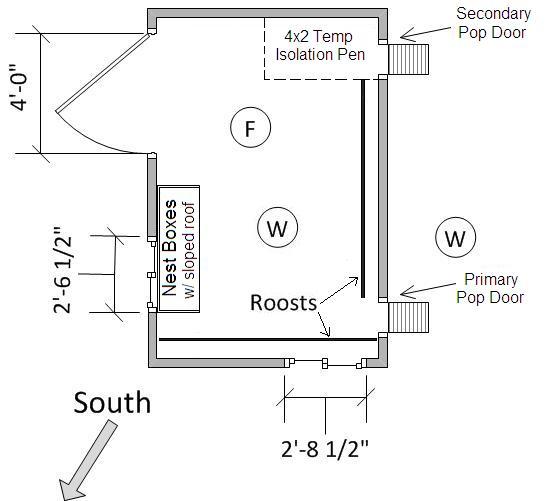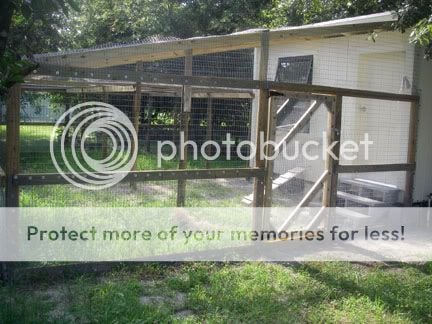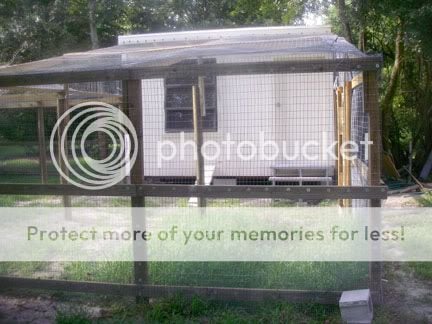I think you are very wise to plan for the future. My basic laying/breeding flock is 7 hens and a rooster, yet I have had as many as 34 chickens, counting newly hatched. I raise my replacement layers plus raise them for meat. Your goals may be different, but you did mention a broody raising chicks. Expect to go well above your 12 you start with.
I am a firm believer in the more space you can provide the better. We have rules of thumb on this forum for the minimum space that will probably keep you out of trouble, but exceeding that space makes management easier. It is not wasted space.
Sounds like your 8' x 12' coop is going to be much nicer than mine. Instead of soffits with vents, I just left the area under the roof between the rafters open and covered that with hardware cloth. Ventilation is not a problem for me, but I am in a different climate. We all do things differently.
They do not need a second chicken door. Having one will not hurt anything, but it is not necessary. A separate area that you can close off if you want to is a pretty good idea. You can leave the door open when it is not in use, so you don't lose the benefit of that space, but it can come in handy to isolate a broody, keep an injured chicken separate from the flock yet with it, as a grow-out pen for brooder raised chicks, or to keep chickens for integration. I'd suggest partitioning off a section of the run outside that second spare door so any chicken kept in there can be let outside and still maintain separation.
A lot of the layout inside is just personal preference. What you have will work. A few things to consider. It is generally best to have the nest boxes fairly dark compared to other areas in the coop. Chickens usually like to lay in places that are hidden from predators and a little dark seems to be a criteria. This does not mean that they will not lay in bright open areas, just that they usually like darker areas. With that much window space, putting them under the windows where the top shades them may be the best spot.
It is best to put the roosts as low as possible yet make sure they are clearly the highest thing the chicken can get to, especially clearly higher than the nest boxes. You do not want them sleeping in the nest boxes. They poop a lot when they sleep and you don't want poopy eggs. So clearly higher roosts. But chickens can hurt themselves getting down from the roosts. It does not happen very often but the larger the chicken is, the more likely it is to happen. When they get off the roosts, they spread their wings and fly down, so it is not like they are doing a cannonball dive to the floor. Many large fowl breeds come off higher roosts every day with never a problem, but why risk it? As low as possible is better. Another thing. The higher the roost, the more horizontal room they need to fly down. Your coop should be plenty big enough to avoid this, but in a tight coop with a high roost, they can hit walls, nest boxes, feeders, waterers, whatever on the way down. Another thing. When they roost, they need to be out of drafts. If they are roosting lower than the level of your vents, any draft from those vents will pass over their backs.
If you do build a storage area, remember they like to roost as high as they can. High shelves make great roosting areas. Also, they will play up on shelves during the day, knocking things off. You might seriously consider some type of door on any shelves. And don't forget dust. Anything you put in the coop will be covered in dust. They shed dander. They poop a lot and it dries out. When they scratch, it becomes dust that coats everything.
Your nest boxes can be any height. You can put them on the floor or as high as you want for convenience of gathering eggs, as long as the roosts are clearly higher. If you raise them off the floor, I suggest raising them high enough above the height of the bedding so they and you have plenty of room to get under there. Under those raised nest boxes can be great places for them to decide to lay eggs. It can be quite cozy and dark. If you don't have enough room, they will scratch the bedding away from the feeder and under the nest boxes, actually raising the level of the bedding under there. If they get blocked off where the chickens cannot get under there, that area becomes a nice safe place for mice to build nests and raise families. If you put your nest boxes at floor level, they might want to hang in there during the day and leave their poopy deposits or scratch stuff from the floor of the coop into the nests. Many people have nests on the floor and love them. Many people have nest higher up and love them.
Since your coop is 12 feet wide, I suggest you consider a run 12 feet wide. It just seems a natural fit. A 12' x 32' run should give you plenty of run room for the size of your coop. I suggest a 32' run as I set my fence posts on 8' centers. I certainly won't argue if you go for a larger run, since more space is always better, but that should be sufficient, especially as you plan to free range them most of the time.
I'm not real familiar with your climate. I assume it is fairly dry but that you do get snow in the winter. Mine don't mind the cold. Mine will go out and play in single digits Fahrenheit weather, provided the snow and wind is not too bad. I've got some that even go out in the snow, but they really don't like wind. They may even go out and play in below zero weather. I just don't get much of that so I don't know. I suspect you will have days in the winter with snow and wind where they may not want to go outside. That is where the extra room in your coop comes in handy. But if you cover a portion of your run with a solid roof, you can keep the snow out (might need to put something up on the fence, a tarp maybe, to block the wind and blowing snow) and give them a place to play even during "bad" weather. A sloping roof will also keep water out of your run, which is a good thing. A solid roof may also help shade them in the summer, another good thing. So I suggest you consider covering the section near the coop with a solid roof.
You have to walk under any roof you put on your run. If you are like me, when you walk you bounce up and down a bit, so you really need the roof high enough to account for your bouncing as your walk. If you are 5'-11", six feet is not enough. Something I strongly urge you to consider. When you wear a baseball type cap, you cannot always see those low sections.
If you don't use a solid roof, I suggest you use some wire fencing to cover the run. Plastic gets brittle and fails pretty quickly.
When someone says they use staples for the fencing, they do not mean those little staples from a hand powered stapler. Predators or just the wind will rip those out. They mean fencing staples, the kind you drive in with a hammer or the really big ones from some powered equipment. Don't take the stapler from your office and expect to do any good. You'd be surprised how many people get confused on this.
Many people attach hardware cloth with screws and large washers. It works and they seem real happy with that method, but I do it differently. I use strips of wood, usually around 1/2" thick, and screw that over the ends of the hardware cloth. I predrill the holes so the wood does not split and make sure the screws go inside a hole in the hardware cloth. That will not come off and it has the advantage of covering the sharp ends of the wire. When you are as graceful as I am, you learn to not leave too many sharp edges around.
Hope you get something useful out of this. Good luck and welcome to the adventure.










